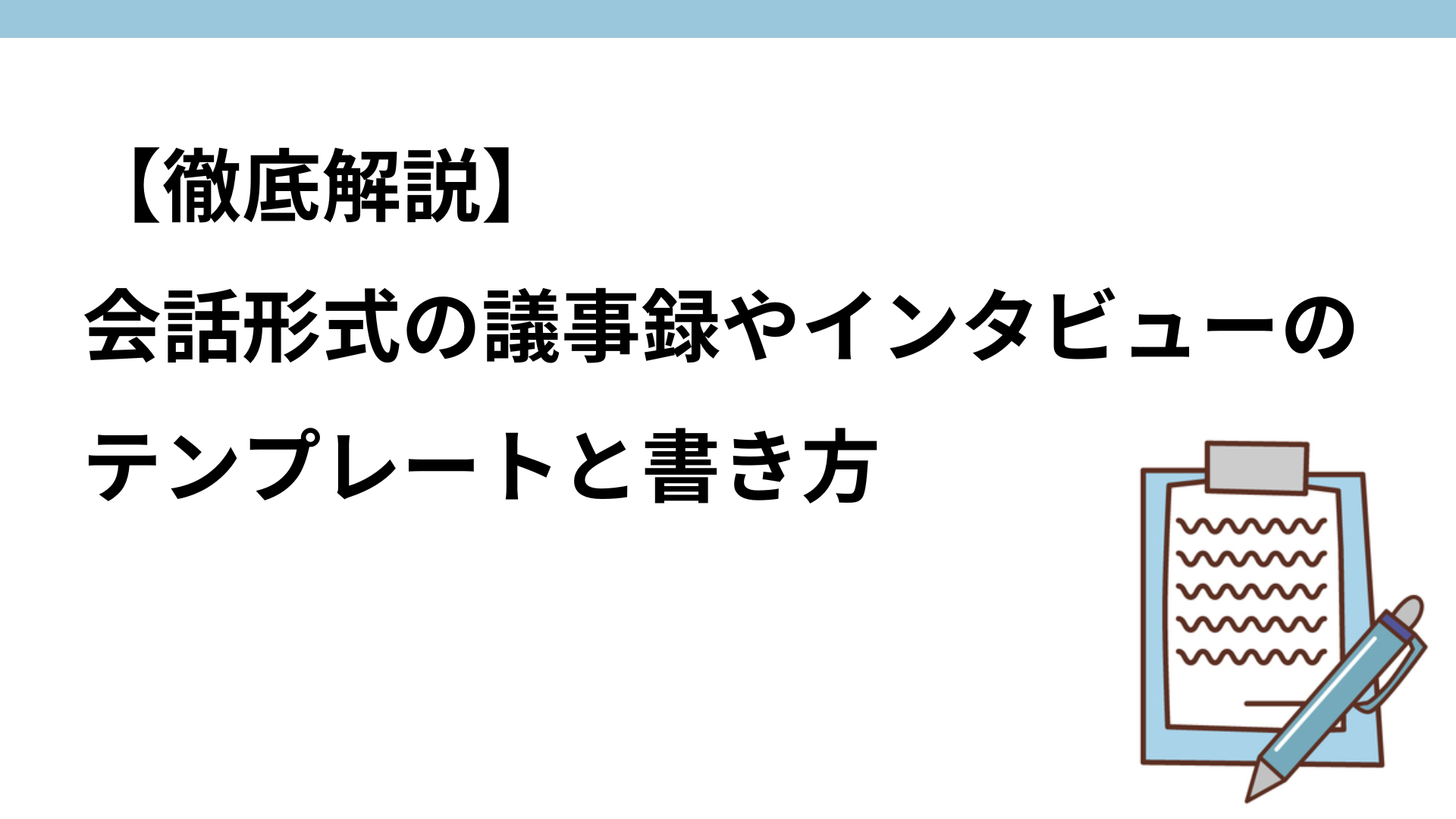Introduction.
Conversational minutes are easy to keep track of the flow of information for each speaker and accurately convey the atmosphere and interactions of a meeting or interview. However, because it is difficult to organize the main points of information, an effective template and writing style are required.
This article introduces a template for compiling conversational minutes and interview articles in a readable and practical manner, and explains the key points of the template.
Characteristics and usage scenarios of conversational minutes/interviews
feature
- The contents are organized by speaker, and the exchange can be understood as it is.
- It is easy to grasp the flow of the discussion and convey the relevance of the questions and answers.
- Organizational skills are required due to the heavy editing load.
Usage Scenes
- Interviews (magazines, blogs, public relations)
- Minutes of business meetings (record decisions, clarify responsibilities)
- Sharing of workshop and seminar content
Tips for writing conversational minutes and interviews
Specify the speaker.
- Name and position should be listed first, followed by “name + statement” repeatedly.
Change the format for different purposes.
- In interviews, clearly separate questions from answers. In meeting minutes, summarize conclusions at the end.
Added supplement to summarize key points
- The main points of longer statements are inserted between the lines as [Points] or [Conclusions].
Balance between recording accuracy and brevity
- Keep only what is necessary, and “kebab” redundant statements.
Example of Conversational Template
Interview format template
[Theme]: Interview about 00
Date: October 17, 2024
Place: Online (Zoom)
Interviewer: Mr. A (Media Editor)
Observer/sub-interviewer: Mr. C (Media Editor)
Respondent: Mr. B (CEO of 00 Corporation)
Interviewer: Question 1 (e.g., Tell me about the background of your product development)
Respondent: Answer 1 (content of answer)
Interviewer: Question 2 (e.g., How has the market reacted?)
Respondent: Answer 2 (contents of answer)
Example of preparation using the interview format template
[ Topic]: Interview about the development of the new product “X100
Date: October 17, 2024
Location: Online (Zoom)
Interviewer: Taro Yamada (Editor)
Respondent: Ichiro Suzuki (President, 00 Corporation)
Yamada: Thank you for taking the time today. Could you tell us about the background of the development of the new “X100” product?
Suzuki: Thank you very much for your time as well. The X100 was developed after more than a year of market research to reflect consumer demands. Particular emphasis was placed on operability and design.
Yamada: Specifically, what aspects are based on user feedback?
Suzuki: For example, many people said they wanted more intuitive operation, so we adopted a one-touch interface.
Yamada: Did you encounter any difficulties in the development process?
Suzuki: Yes, we had to review some of the manufacturing processes because the cost of the originally planned materials had skyrocketed. However, we proceeded with caution to ensure that quality would not suffer as a result.
Yamada: Finally, please tell us about your thoughts on this product and your future outlook. Suzuki: We would be happy if “X100” can enrich users’ lives even a little. We are also looking to expand into overseas markets in the future.
Meeting Minutes Template
[Meeting name: “00 Meeting
Date & Time: YYYYY MM/DD Date: 00:00 – 00:00
Place: Online (or name of meeting place)
Attendees: Name and position (e.g., Mr. Tanaka, General Manager, Mr. Sato, Section Chief)
Agenda: About 00
Minutes
Regarding Agenda Item 1
XX: “……..”
XX: “……..
Regarding agenda item 2
XX: “……..”
00: “……..”
Next Action (TODO)
Action: Contact person, Due date
Action: Contact person, Due date
Next scheduled meeting date: YYYYY MM/DD at 00:00
Examples of meeting minutes created using the meeting minutes template
[Meeting Title: October Marketing Strategy Meeting
Date & Time: October 17, 2024 10:00-11:00
Place: Zoom (online meeting)
Attendees: General Manager Tanaka, Section Manager Sato, Mr. Suzuki
Agenda: Market development of new products
Tanaka: First, regarding the market target for new products, what area should we focus on?
Sato: I think it is appropriate to target people in their 20s and 30s in the Kanto area.
Suzuki: We also believe that SNS advertising is effective for that generation.
Point】Introduction of SNS advertising will be an issue for consideration, and details will be confirmed at the next meeting.
Tanaka: Let’s put together a concrete proposal including a budget at the next meeting. That’s all for today.
Points for streamlining record keeping
Utilize voice recording and transcription tools
Since it is important not to miss any details of the conversational format, it is effective to use voice recording tools or automatic transcription tools to revise and edit later.
Interview AI can transcribe an hour-long audio file in as little as 15 seconds, after which the AI automatically performs “filtering” and “sentence alignment” as well.

If you are doing transcription manually and are worried about time and cost, please consider an AI transcription tool such as Interview AI.
Share formats in advance.
Preparing and sharing a template of the minutes in advance of the meeting or interview will make it easier for participants to organize what they will say.
Separate the summary of statements from the details.
The entire document should be kept compact by inserting a “summary” of important statements in the body of the text and details as [Supplement].
summary
While conversational minutes and interview articles make it easier to grasp the flow of statements, they are also time-consuming to edit. By combining the recording of each speaker with the organization of key points, smooth and easy-to-understand articles can be created. By utilizing templates and recording in a format suited to the purpose, work efficiency can also be improved.

